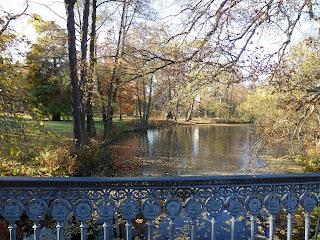At the East End of King’s College Chapel stands
Rubens’ monumental altarpiece The
Adoration of the Magi. Painted c.1634 for the Dames Blanches convent in
Louvain, its luminous colours and arresting nocturnal effects are familiar to
all fans of A Festival of Nine Lessons
and Carols, broadcast on Christmas Eve, a picturesque occasion quintessentially English in spirit.
One would hardly have guessed the controversy that
surrounds its installation. While the vacuous display of intellectual
self-gratification that is this year’s Turner Prize challenges the viewer only
in their ability to stifle a yawn, this seemingly innocent artwork has
fomented the ire of many a conservationist and Edwardian enthusiast, many
calling for its removal, an opinion gaining ground among the general public. Not that this is sensible: in 1968 the floor of the
East End was lowered to specifically accommodate it, demolishing Tudor brick archways
(apparently recycled as crazy paving) and exhuming graves dating back to the
fifteenth century. The Edwardian panelling that once covered the stonework is
in storage, and the altarpiece itself is challenging to manoeuvre, taking ten
men two hours to carry it across the college courtyard when it was first
acquired; moreover, the terms of Major Alnatt’s bequest preclude the Rubens
being displayed anywhere else, the chapel’s oblong shape and altarpiece’s
colossal size not allowing for a change in position. The proverbial toothpaste cannot
be put back in the tube so easily.
Many of those opposing the altarpiece today apparently hold
Rubens' art in some disdain. Graham Chainey cites Joshua Reynolds’ dismissal of
it as a ‘slight work’, carelessly banged out in just over a week, as if
Reynolds’ aesthetic judgements are somehow infallible (just like his experiments with bitumen). Writing in the Spectator, Simon Blow, grandson of
Detmar Blow, who designed the chapel’s Edwardian reredos, laments how ‘the
Rubens dominates’ and ‘blank stone walls stare at you’. The acquisition, lament
the critics, is the fallout of titanic egos clashing, namely Michael Jaffé, a “Rubens obsessive”.
Cambridge’s first lecturer in Fine Arts and later director of the Fitzwilliam
Museum, he is accused in the Spectator
of bisexual promiscuity and bloody-minded arrogance. Is this deserved?
‘This munificent gift and rare addition to the
worship, dignity, and beauty of the Chapel’ was how King’s described the Rubens
in 1961. Kenneth Clark urged its acceptance with his watershed BBC series Civilization in production; only Nikolaus
Pevsner opposed its installation. Detmar Blow’s romanticised painting from the
1900s, with warm sunlight flooding the East End, fails to capture the dismal
gloom of winter months that precipitated its renovation. The ‘brown Windsor
soup’ of Blow’s ‘Edwardian mannerist’ panelling, as Jaffé so aptly described it, is no great loss to the
Chapel’s glorious Tudor filigree stonework. As handsome as the reconstructed stained
glass is, services in the East End required a focal point at eye level.
By today’s standards, the renovation of the East
End in the 1960s was certainly a botched job. The naked stone walls are too
austere, and the risible reframing of the Rubens as a faux triptych (the
original sold to Michael Heseltine) has something of the Ikea aesthetic, to say nothing of the desecration of the chapel's crypt. Vandalised
by the IRA in the 1970s, it is kept behind absurdly distant barriers to this
day, keeping the hoi-polloi at a football stadium's distance. Nevertheless, the painting as it stands does great justice to the spectacular
setting of King’s, and vice-versa. Rubens’ warmly luminous palette gives colour
to an otherwise forbidding architectural space, its grandiose proportions comfortably
accommodated by the chapel’s soaring vaults. The combination is best
appreciated during services, where art, architecture and exquisite choral
singing intertwine in what could be called a Gesamtkunstwerk – a total work of art. Although flawed, the special candlelit atmosphere of evensong or Christmas Eve does much to iron out the creases.











































